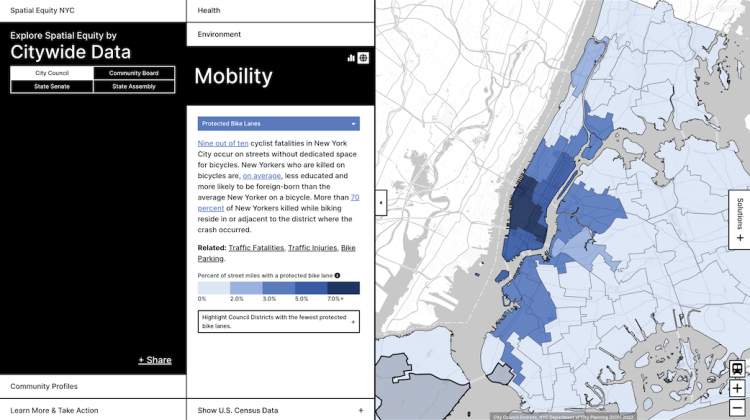Mapping Inequity in NYC

Access to resources and amenities are often unequally distributed across a city’s neighborhoods. Factors such as socioeconomic status, ethnicity, and race have been linked to the allocation of resources in relationship and causal studies. But what metrics and data points are we utilizing to understand the spatial differences in neighborhoods? And once we have a universal criteria for an entire city, who has access and who can leverage the accumulated data to champion more equitable investment?
Spatial Equity NYC is a free digital tool that maps and analyzes how the amenity of public space is utilized and allocated in New York City. The tool, recently updated and expanded, maps data to each district with comparisons across 24 layers of data to help users understand the resources available and disparities across communities. The tool and its data visualizations were designed to be accessible to a wide range of stakeholders and encourage wider participation in advocating for changes and resources that communities in New York require to be healthy, productive, safe, and joyful spaces.
“While much of the data we need to advocate for communities exists openly it is hard for policy makers to obtain it, and if they can access it, perform the quantitative analysis that shows how well their community measures up to others,” says Sarah Williams, director of the Leventhal Center for Advanced Urbanism (LCAU). “Spatial Equity NYC fills that gap, and by making it easier to see how well your community is doing, thereby making it much easier to advocate for change.”
To design and build the tool, the LCAU collaborated with New York City’s Transportation Alternatives, an organization dedicated to advancing changes in public policy, street design, enforcement, and resource allocation that transform the city’s streets for the better. The LCAU, a center within the School of Architecture and Planning at MIT, seeks to establish a new theoretical and applied research platform to create knowledge that can be used to transform the quality of life throughout the urbanized world. The LCAU works towards achieving their mission through collaborative interdisciplinary research projects using design as a mode of inquiry, intellectual discourse, and dissemination through leadership forums, conferences, publications, and teaching.
In addition to the leadership and guidance from Williams, the MIT team included: Hanah Shumway, Enrique Casillas, Adi Kuperschmidt, Linh Nguyen, and Sebastian Ives.


